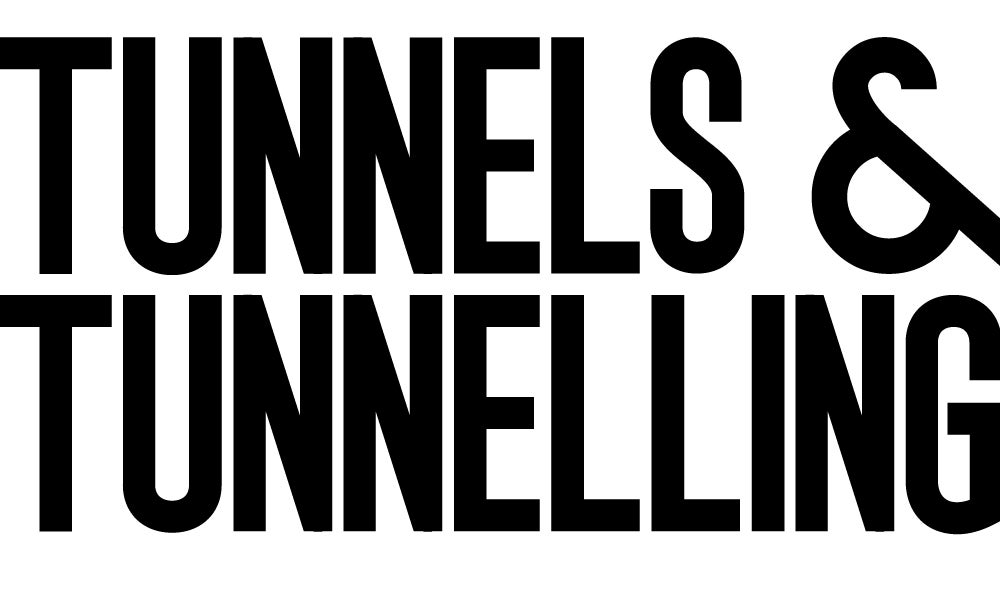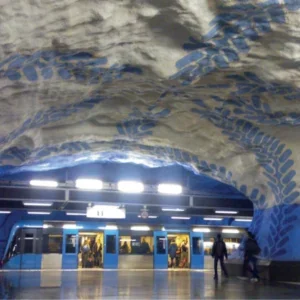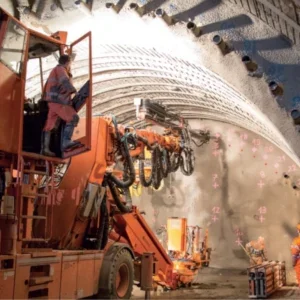The world was stunned last year by the scale, rapidity and intensity of the all- consuming traffic fire which broke out in the two lane Mont Blanc road tunnel between Italy and France. The fierce heat and dense smoke claimed 39 lives as it reduced vehicles virtually to molten puddles (T&TI May 1999). A stretch of the tunnel, roughly 1km long, was severely damaged in the Italian sector.
The importance of fire control was underlined almost immediately with a second tragic fire at Austria’s Tauern tunnel in May (T&TI August 1999). There, another 12 people died.
Just how tunnels should be fitted out, or upgraded for fire and emergency, has taken on a new urgency worldwide ever since. Some engineers say it is now the priority issue in design of new tunnels.
It was immediately clear that Mont Blanc could not simply be repaired but must be re-engineered to prevent any repeat of the disaster. Changes in the way it was managed and manned for safety were needed.
While international experts have debated, so too have local residents of the Alpine valleys on either side. Some have declared they do not want the tunnel put back at all, preferring traffic free tranquillity.
The trade and tourist links to Italy from Switzerland and France are too important. But even so, says Bertrand Levy for the Autoroutes et tunnel du Mont Blanc (ATMB) the resistance is one reason why the route cannot be doubled. A second bore is the favoured solution for the Tauern tunnel, giving safer unidirectional traffic flows. But there, expansion was already under consideration.
A second bore under the high Alps would be much too expensive and time consuming, and certainly beyond the resources of the French side concessionaire ATMB and its Italian counterpart SITMB (Societea Italiano di Tunnel di Mont Blanc), even with the European money that will part fund the rebuild. The two organisations, making up the Societe d’Exploitation du Tunnel de Mont Blanc, each control half the length of the 11.6km tunnel.
Instead the solution is to install deep rock shelters along the tunnel at 300m intervals. Alongside, emergency and monitoring systems will be upgraded to “the most comprehensive in the world” using automated TV and temperature monitors. A permanently manned fire station will be located halfway along the tunnel.
The new structures match parameters for safety established following the joint Franco-Italian government disaster inquiry. Its report, published in July 1999, made some 41 points. It recommended improved coordination by the Intergovernmental Control Commission for the tunnel and improved joint management as well as physical measures to improve fire safety structures and control of traffic.
Recommendations of a Scientific & Technical Committee of six Italian, French and Swiss experts appointed by the two tunnel operators were submitted to the Inter-governmental Control Commission in July. ATMB says the proposals echoed many of the inquiry points, such as doubling the number of refuges and allowing an escape route through the fresh air vent ducts.
The ICC then created a special security committee to examine and approve the measures for the works programme before they began, with cleaning operations starting in spring this year.
Much of the detail of the equipment to be installed is still being finalised by the two concessionaires, contracts being let for the whole tunnel length. It will account for about half the overall spend.
Meanwhile a crash programme of civil engineering work is under way. Work for the basic excavated structures is let separately on the two sides because of the difference in the civil engineering markets and regulations. ATMB and SITMB act as “maitre d’ouvrage” or engineering manager, with a joint technical management team from the two concessionaires headed by Jean-Yves Lapierre for the ATMB and Vincenzo Pozzi for the Italian SITMB.
In Italy, where the tunnel fabric was heavily damaged by the fire, contracts are already let for repair work on the lining. At the fire point, the 700mm thick lining collapsed completely and a considerable length was damaged. Under contracts carried out over the summer, the ruined concrete has been cut away and the tunnel vault reconstructed. Where the lining is partly damaged, it is water jet blasted back to sound concrete.
Since July, major civil engineering to upgrade the 8.6m id tunnel has been under way.
On the French side, the summer period saw cleaning works on the tunnel and minor repairs to the concrete road deck. By the end of September another contract to restore the electrical and communication systems was also completed.
ATMB announced the major E25M ($21.46M) civils programme. This began with a six week preparation period before an intensive, round the clock excavation and construction programme started up in mid-October, lasting 17 weeks. The award went to a French Italian joint venture of Bouygues, GTM-Dumez and Impregilo.
The work is explained by Laurent Samama, project engineer for the maitre d’oeuvre (designer and engineering supervisor) a JV of specialist consultant Scetauroute and Spea.
The contractor, he says, must create a variety of rock structures. First and foremost are the 19 deep rock shelters, sited at 300m intervals. Currently there are so-called “garages” every 150m along the tunnel, a widening to three lanes where cars can pull in. Each alternate garage has a small open rock chamber opposite. Tunnel-side walled fire shelters were sited every 600m with a telephone inside.
The new shelters will be housed on one side of excavated caverns at right angles to the roadside. Each will be 2.5m high rising to 5.5m at the centre with a surface area of 37.5m². Minimum width will be 3.4m, though geometrical configurations will vary at each one.
On the other side of the vault are an equipment room and fire connection point. A central stairway will lead down to ventilation ducts – four longitudinal chambers some 2.5m high at the centre of the tunnel rising to 3.5m near the portals. These will serve as escape routes, being kept smoke free by the ventilation positive pressure.
Ventilation in the tunnel is by a semi-transverse system, to be beefed up with bigger fans to provide additional pressure and to speed smoke and fume extraction. Total power will be increased from 4MW to around 10MW. Ventilation will be boosted in the event of fire by jet fans, thought to be the first time they have been used in this way.
Excavation work will be needed to beef up the extraction side of the system. Currently, top-of-vault vents draw exhaust down into an under-road extraction duct at 300m intervals.
These will be enlarged to 1.5m² cross section and new ones created in the tunnel wall, making 62 in all, ensuring extraction at 100m intervals. The system will be capable of emptying a maximum 150m³/sec for every 600m length of tunnel: remotely operated vent doors will be able to concentrate extraction power in a single area.
Civils work will also include the excavation of a central tunnel fire station with a 45m² area. One light fire vehicle and one specialist heavy appliance will be stationed here along with three duty firefighters who will monitor TV and other detector systems, and complement the resources at either end of the tunnel.
Finally, some 58 emergency communication points and 20 fire points will be added. The former will comprise an extinguisher and telephone, and the latter hydrant connections in both French and Italian standard fittings. The 1.5m wide and 1.2m deep “niches” will have a surface area of 1.8m², with doors which will unlock automatically when an alarm is pushed.
The excavation works, which will extract 55,000t of mainly granite rock and 5100m³ of demolished concrete, are to be completed in just 11 weeks after a contract preparation of six weeks which began on 9 September. “The logistics are quite complex,” says Samama “because all the material and men must be moved in from the portal.”
Two Atlas Copco three boom jumbos are to be brought in, plus a two boom rig, probably a Montabert. Drill and blast will deal with the bigger excavations though an expansive gel method is envisaged for the smaller niches. “This is for safety reasons in such a crowded work site,” says Samama.
Two robot spray concrete units will apply the total 5000m³ of shotcrete, and the equipment inventory will also include six special formwork units and proprietary formwork, articulated dumpers, hydraulic excavators and concrete pumps.
The ventilation ducts will be created by both drill and blast or by excavator-mounted hydraulic rock breakers where they pass under the road.
As might be expected, safety of the construction operation is seen as paramount by the concessionaires. A series of measures regulate site communications and access, including four supervisors concentrating on site safety.
When the civils work is complete, a suite of new control systems will be installed, including automated TV incident detectors, vehicle temperature monitors for heavy lorries, and road bed traffic flow detectors. These are intended to maintain traffic speed and separation regulations as well as monitor for incidents.
Tunnel signage will be greatly enhanced with red light signals and variable message information signals at 600m intervals. And remote controllable traffic barriers will prevent the accumulation of vehicles.
Related Files
Excavation Work






